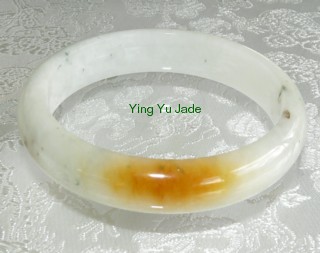
Ying Yu Jade
Jade Natural and Enhanced Color
Testing jade to determine if the color is natural or enhanced is a specialized field and difficult for a person to tell when shopping for a jade piece. There are filters that help gemologists to see if the color is genuine, including jadeite filters, or chelsea filters, and lights, but you have to know how to use them and what you are looking for. Jade that is sold with a Chinese or Hong Kong certificate is often color treated, and the certificate might state that the jade is genuine and the color is natural. There's a market for these fake jade certificates, so they are not reliable.
There's nothing "wrong" with color treated jade. The jade mines in Burma (Myanmar) have been closed because of the economic and political problems, so most of the jadeite available is not "fancy". Most of the jadeite that is commercial quality is pale green, has some nice green veins, but it's very rare to find "hong" or red/orange color, honey/yellow and lavender color that is natural. The price for the colors is very high for most people's budgets. But there's a lot of natural jadeite that is grey color with lots of dark spots that is color treated to make it sell, mostly to people who live outside of China, because Chinese people prefer the soft pale color jade with some green veins for contrast. The color treating process has evolved to a very good quality with the color semi-permanent and will hold up for years. First, the grayish/spotty solid jadeite is bleached with acid to remove all the color and make it translucent. Unfortunately, this acid bleaching makes the jade very brittle, and is called "C" quality jade. The stone barely resembles jade stone. Then color is added, usually a resin type of color to make it "pretty". The good quality of color treated jadeite is well done, and takes a great deal of time, so the cost is often higher than natural jadeite even when the color is not very good in its natural state. This commercial quality color enhanced jade is sent to Hong Kong and jade markets for sale to jade dealers who sell outside of China.

This is an example of jadeite
that is natural and would be acid bleached and color added to make it
commercial quality. But this shows off the natural stone, and is preferred
by Chinese people
Some people believe that if their jade has been purchased in Hong Kong, it's the best quality, because it comes with a certificate. During my last visit to Hong Kong April 2009, I didn't see any natural color jadeite in the Hong Kong jade market but all of them had "certificates" stating they were genuine jadeite with natural color. And all the jade sellers promised that the color was natural, but to my trained eye, it certainly was not.
This is what I looked for. When I looked at an area of red, yellow or honey, I looked for a vein pattern, not a splotch of color. And I looked at the edges of the color. This is a photo I got from a woman who asked for my opinion on the color.

Notice the splotchy appearance of the color. And at about three o'clock you can see how the color fades from a reddish to a more yellow color. This is an example of how you can see low quality color enhancement.

The color above is even, and you can see dark "pepper" veins of charcoal around the bangle and in the color section. This jadeite has not been bleached out and you can see the the natural "pepper" is throughout. This "pepper" is also called "butterfly" pattern. This jadeite bangle is $2800 and you would expect to pay this much or more for natural color, a "fancy" jadeite bangle.

This lavender jadeite bangle
is a perfect example of natural color in a $500 price range. To make it
more "valuable", a jade carver might wash it with acid to make
it more translucent. You can see the "stone" pattern above,
but in an acid washed jade you don't see the stone, the lines, the "flowering",
although some clever jade carvers can add "stone pattern" to
appear natural. Lavender color is highly desired by many jade lovers,
and you can expect to pay much more for lavender color than green color
because it's more rare. This jade bangle has some green and lavender and
is an old mine "lao pit" jadeite, with fine grain and high chime,
making it a very cherished jade. It's not translucent, but it's wonderful
natural color.

This is another example of unbleached,
all natural jadeite, the carver using the darker mossy green as a highlight
on soft lavender. It's traditional color jadeite, but for commercial sales
it would probably be acid washed, color added "C" grade to make
it "prettier". You have to love natural jadeite to appreciate
the color and quality of the jade bangle above. This kind of jade gets
prettier as you wear it, the jade qi energy and your body qi energy work
together to make you healthier and happier, and your jade will glow with
your healthy qi.
And that's the reason you would choose natural "A" grade jadeite over color treated jadeite which Western people and some Asian people consider to be "prettier". The Chinese people have worn jade for it's qi energy qualities, and believe that their jade becomes a part of them when they wear it all the time. Color treated jades loses much of it's "jade nature" so you wear it for the times you want beautiful jewelry.